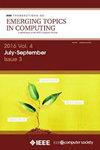智能社会中图形处理的边缘-云协作框架
IF 5.1
2区 计算机科学
Q1 COMPUTER SCIENCE, INFORMATION SYSTEMS
IEEE Transactions on Emerging Topics in Computing
Pub Date : 2023-07-24
DOI:10.1109/TETC.2023.3297066
引用次数: 0
摘要
由于云计算在延迟、带宽和数据保密性等方面的限制,边缘计算作为一种新颖的位置感知方式应运而生,它可以为容量受限的便携式终端提供更多处理能力,从而提高计算性能和服务质量(QoS),适用于智能社会中人类活动的多个典型领域,如社交网络、医疗诊断、电信、推荐系统、内部威胁检测、交通、物联网(IoT)等。这些应用领域通常管理着大量具有各种关系的实体集合,这些实体可以自然地用图数据结构来表示。图处理是对涉及图数据的复杂问题进行建模和优化的强大工具。考虑到边缘设备的资源供应相对不足,我们在本文中首次提出了一个可靠的边缘-云协作框架,该框架基于轻量级交互式图处理库(GPL),特别是以最短路径搜索(SPS)操作为例,促进了图原语的使用。此外,还介绍了两类不同的实际案例,以展示我们的图处理策略的典型应用场景。实验评估表明,通过图缩减,性能加速率可达 6.87 倍,导航和大流行病控制分别只需不到 3% 和 20% 的额外延迟,就能获得更好的用户体验,而在线安全措施只需消耗整体数据传输约 1% 的额外时间。考虑到用户友好性、低延迟响应、边缘设备之间的交互、边缘与云之间的协作以及隐私保护,我们的框架能以可接受的开销高效地执行应用程序。本文章由计算机程序翻译,如有差异,请以英文原文为准。
An Edge-Cloud Collaboration Framework for Graph Processing in Smart Society
Due to the limitations of cloud computing on latency, bandwidth and data confidentiality, edge computing has emerged as a novel location-aware way to provide the capacity-constrained portable terminals with more processing capacity to improve the computing performance and quality of service (QoS) in several typical domains of the human activity in smart society, such as social networks, medical diagnosis, telecommunications, recommendation systems, internal threat detection, transportation, Internet of Things (IoT), etc. These application domains often manage a vast collection of entities with various relationships, which can be naturally represented by the graph data structure. Graph processing is a powerful tool to model and optimize complex problems where graph-based data is involved. In consideration of the relatively insufficient resource provisioning of the edge devices, in this article, for the first time to our knowledge, we propose a reliable edge-cloud collaboration framework that facilitates the graph primitives based on a lightweight interactive graph processing library (GPL), especially for shortest path search (SPS) operations as the demonstrative example. Two types of different practical cases are also presented to show the typical application scenarios of our graph processing strategy. Experimental evaluations indicate that the acceleration rate of performance can reach 6.87x via graph reduction, and less than 3% and 20% extra latency is required for much better user experiences for navigation and pandemic control, respectively, while the online security measures merely consume about 1% extra time of the overall data transmission. Our framework can efficiently execute the applications with considering of user-friendliness, low-latency response, interactions among edge devices, collaboration between edge and cloud, and privacy protection at an acceptable overhead.
求助全文
通过发布文献求助,成功后即可免费获取论文全文。
去求助
来源期刊

IEEE Transactions on Emerging Topics in Computing
Computer Science-Computer Science (miscellaneous)
CiteScore
12.10
自引率
5.10%
发文量
113
期刊介绍:
IEEE Transactions on Emerging Topics in Computing publishes papers on emerging aspects of computer science, computing technology, and computing applications not currently covered by other IEEE Computer Society Transactions. Some examples of emerging topics in computing include: IT for Green, Synthetic and organic computing structures and systems, Advanced analytics, Social/occupational computing, Location-based/client computer systems, Morphic computer design, Electronic game systems, & Health-care IT.
 求助内容:
求助内容: 应助结果提醒方式:
应助结果提醒方式:


